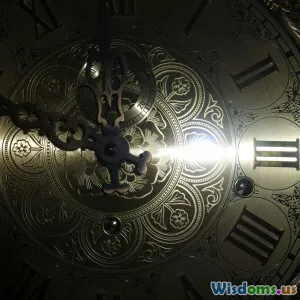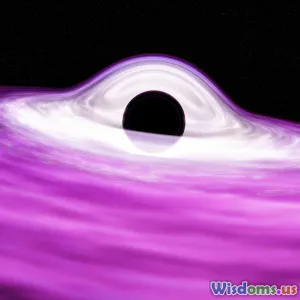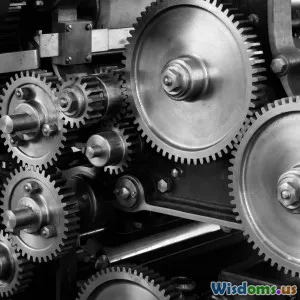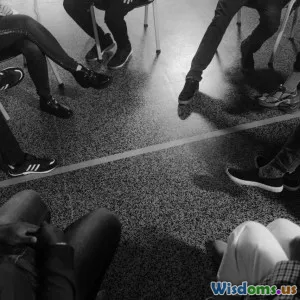
Relativity Explained: Why Time Slows Near Massive Planets
13 min read Unveil the mysteries of relativity and discover why time slows down near massive planets, with engaging explanations and real-world examples. (0 Reviews)
Relativity Explained: Why Time Slows Near Massive Planets
Introduction
Have you ever wondered if time is constant and universal? What if time ticked differently for an astronaut standing on the surface of Jupiter versus someone staying safely on Earth? Or, more dramatically, what if you could glance at the clock while skirting the edge of a black hole—and witness hours pass in mere minutes compared to your distant friends? This is not science fiction. It’s the mesmerizing reality of our universe, described by one of the most revolutionary scientific discoveries of the 20th century: Einstein’s theory of relativity. At its heart lies a mind-bending truth—time itself slows down near massive objects. But why?
In this in-depth exploration, we’ll dive into how gravity affects the flow of time, the dazzling experiments and real-world proofs, and why this phenomenon matters—profoundly shaping our understanding of the cosmos and the way we use technology on Earth. Grab your figurative space helmet; we're about to journey through warped spacetime!
The Foundations of Relativity
Einstein’s Breakthrough: Moving Beyond Newton
For centuries, Isaac Newton's laws of gravity reigned supreme. Gravity was described as a force pulling objects toward each other—a harmonious explanation for falling apples and orbiting planets. Yet, Newton’s framework always assumed time ran at the same pace everywhere, a cosmic constant as unbreakable as the speed of light.
It took Albert Einstein in 1915 to shatter this assumption. In his general theory of relativity, Einstein proposed a radical idea: gravity isn't a force between objects, but rather the curvature of space and time (spacetime) caused by mass and energy. Objects like planets and stars create 'dents' in the fabric of spacetime, which affects how not only matter, but also time itself, behaves.
“The distinction between past, present and future is only a stubbornly persistent illusion.” — Albert Einstein
Space and Time Become Fluid
General relativity weaves space and time together. They are not separate arenas where cosmic events unfold; rather, they merge into a four-dimensional tapestry—spacetime. Massive planets and stars curve this spacetime, influencing how objects move and—crucially—how time ticks.
The Key Equation: The Metric of Spacetime
Einstein’s famous field equations reveal how spacetime curvature (and thus gravitational strength) shapes everything, including the pace of clocks. Where spacetime is most distorted, near massive objects, the flow of time changes detectably.
Gravitational Time Dilation: The Heart of the Mystery
How Gravity Stretches and Slows Time
The concept of gravitational time dilation lies at the heart of this strange phenomenon. According to relativity, the stronger the gravitational field (i.e., the closer you are to a massive object), the slower time passes compared to a region with weaker gravity.
Think of it like this: massive planets sit atop ‘bowls’ in the cosmic rubber sheet. A clock closer to the bottom of a bowl ticks ever so slightly slower than one resting closer to the rim – or far from the bowl entirely.
Real-World Analogy: Mountains and Valleys
Imagine race car drivers zipping around two different tracks. One track runs through a valley, representing a strong gravity field, the other along a mountain ridge (weaker gravity). The racer in the valley’s car (the clock near a massive planet) moves a bit slower—relative to the outside world—thanks to the gravitational slog.
The Mathematical Expression
This change in the flow of time can be expressed scientifically:
t0 = tf √(1 - 2GM/rc²)
Where:
- t₀ is the time passed close to the massive object
- tf is the time experienced at a far distance
- G is the gravitational constant
- M is the mass of the planet or star
- r is the radial distance from the center of the mass
- c is the speed of light
If you’re close to a massive planet (r is small), the argument under the square root shrinks, so the time you experience (t₀) becomes less than the time experienced further away (tf). Simply put: near a massive body, time slows.
Compelling Examples and Experiments
The GPS System: Precision Lost Without Relativity
Remarkably, understanding gravitational time dilation is no longer confined to chalkboards and textbooks—it is an essential aspect of everyday technology! The Global Positioning System (GPS) relies on super-precise clocks inside satellites orbiting Earth.
- Satellites are farther away from Earth's center, where gravity is weaker, so their clocks tick slightly faster than clocks on the surface.
- The difference is about 45 microseconds per day per satellite. That may sound minuscule, but without corrections based on Einstein’s theory, GPS would yield location errors growing by several kilometers each day—rendering navigation completely unreliable.
Thus, our phones and cars would literally get lost without relativity.
Twin Paradox: A Tale of Aging Astronauts
The famous thought experiment known as the Twin Paradox illustrates both special relativity (time slows at high speeds) and general relativity (time slows in gravity wells). Suppose one twin remains on Earth, while the other travels near a black hole and returns. Due to gravitational time dilation, the traveling twin would have aged less than their earthbound sibling.
This isn’t just theory. The difference is minuscule for planets but becomes extreme near objects like neutron stars or black holes, where time virtually stands still compared to the rest of the universe.
Hafele-Keating Experiment: Time Flies (Differently) Around the World
In 1971, physicists Joseph Hafele and Richard Keating flew atomic clocks westward and eastward around the globe in commercial airliners. Upon their return, the traveling clocks exhibited time shifts just as Einstein had predicted—showing not just the impact of motion (special relativity), but also gravity (general relativity). Clocks closer to Earth’s surface (where gravity is stronger) indeed ran slightly slower than those in the sky.
- Fact: Measured differences were on the order of tens of nanoseconds, small, but perfectly predicted by relativity.
Extreme Environments: Black Holes & Time Freezing
For ultimate proof that gravity affects time, consider a black hole: a region where gravity is so intense, not even light can escape. Time slows so dramatically approaching the event horizon that, from an outsider’s perspective, it appears to freeze.
Quoting physicist Kip Thorne, “To a distant observer, an object falling into a black hole appears to slow and stop at the event horizon, frozen in time forever.” However, to the infalling object itself, time ticks normally until the gravitational difference between body and environment becomes infinite—a literal rift in the fabric of reality.
Unraveling the Implications
Everyday Impact: Engineering, Navigation, and Communication
While the most dramatic effects appear near cosmic giants, gravitational time dilation is crucial even on Earth. Besides its necessity in GPS, timekeeping at the highest level—atomic clocks running in labs and space observatories—must account for minuscule differences in gravitational potential. Skipping these corrections would topple the infrastructure behind navigation, banking, secure communications, and scientific research.
Scientific Frontiers: Astrophysics and Cosmology
Understanding warped time is central to astrophysics:
- Star Evolution: Accurately predicting how stars die requires adjusting for time dilation near dense corpses, like white dwarfs or black holes.
- Cosmic Horizons: Observing the edges of the visible universe, astronomers receive light bent or aged by encounters with immense galaxies and clusters—which also alter time.
- Fundamental Physics: Testing the extremes of gravity, such as those near black holes, offers clues into merging quantum mechanics with relativity—a sought-after “theory of everything.”
Science Fiction Comes Real: Movies and Literature
Science fiction has famously leveraged the oddity of warped time:
-
In the movie Interstellar, trying to rescue a stranded astronaut on a planet orbiting close to a black hole leads to stunning time discrepancies. A few hours on the surface translates into years for those waiting on the ship, a scene consulted on by real-life physicist Kip Thorne himself.
-
Classic literature, like H.G. Wells’ The Time Machine, imaginatively explores time’s mutability—paralleling concepts not made explicit until Einstein.
Exploring Relativity with Real-World Examples
Jupiter: A Local Case Study
Consider our neighborhood giant, Jupiter—the most massive planet in our solar system. The gravity at Jupiter’s cloud tops is about 2.5 times stronger than Earth’s. If you set up identical atomic clocks on Earth and on Jupiter (hypothetically, without them getting crushed or dissolved!), the Jupiter clock would fall ever-so-slightly behind, ticking slower in the grip of stronger gravity.
- Calculation Example: The difference is tiny, measurable only with the finest clocks—on the order of microseconds per year. Still, over decades or centuries, these shifts would become pronounced.
High-Altitude Timekeeping
Closer to home, mountain climbers on Everest literally age a smidgen faster than those at sea level—gravity is just slightly weaker high up, causing time to pass more swiftly (by about 15 microseconds over a year at the summit compared to sea-level dwellers).
Milky Way Black Hole: Sagittarius A*
At the Milky Way’s center lurks Sagittarius A*, a supermassive black hole. Orbiting stars, known as ‘S-stars,’ whiz in extreme gravity, experiencing wild time dilation effects. Astronomers have actually observed these effects, confirming relativity’s predictions to remarkable precision.
Frequently Asked Questions and Surprising Insights
Can We
Rate the Post
User Reviews
Popular Posts

















